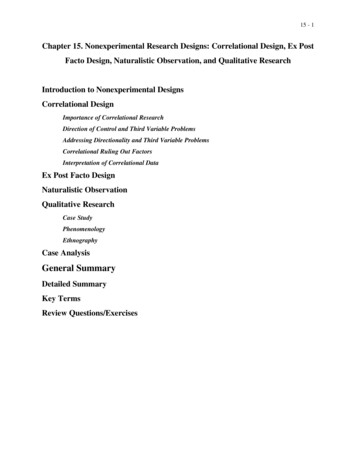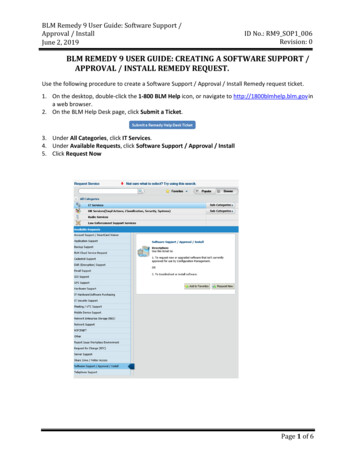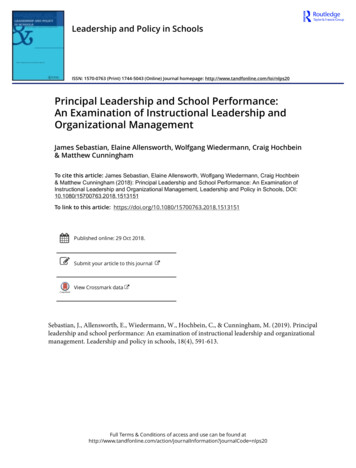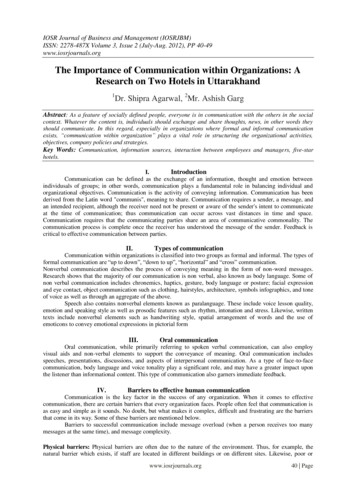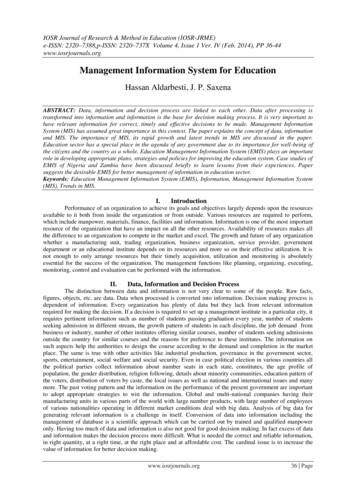
Transcription
Recognising the Importance ofSoftware in Research –Research Software Engineers(RSEs), a UK ExampleOpen Science Monitor Case StudyJon Switters, David OsimoJanuary – 2019
Recognising the Importance of Software in Research – Research Software Engineers (RSEs), a UKExample - Open Science Monitor Case StudyEuropean CommissionDirectorate-General for Research and InnovationDirectorate A — Policy Development and CoordinationUnit A.2 — Open Data Policy and Science CATIONS@ec.europa.euEuropean CommissionB-1049 BrusselsManuscript completed in December 2018.This document has been prepared for the European Commission however it reflects the views only of the authors, and theCommission cannot be held responsible for any use which may be made of the information contained therein.More information on the European Union is available on the internet (http://europa.eu).Luxembourg: Publications Office of the European Union, 2019PDFISBN 978-92-76-00896-5Doi: 10.2777/787013KI-01-19-256-EN-N European Union, 2019.Reuse is authorised provided the source is acknowledged. The reuse policy of European Commission documents is regulated byDecision 2011/833/EU (OJ L 330, 14.12.2011, p. 39).For any use or reproduction of photos or other material that is not under the EU copyright, permission must be sought directlyfrom the copyright holders.
EUROPEAN COMMISSIONRecognising the Importance ofSoftware in Research –Research Software Engineers(RSEs), a UK ExampleOpen Science Monitor Case Study2019Directorate-General for Research and InnovationEN
Table of Contents1.About research software engineers in open research .42.Drivers .63.Barriers.74.Impact .85.Lessons learnt . 116.Policy conclusions . 11References . 132
ACKNOWLEDGEMENTSDisclaimer: The information and views set out in this study report are those of theauthor(s) and do not necessarily reflect the official opinion of the Commission. TheCommission does not guarantee the accuracy of the data included in this case study.Neither the Commission nor any person acting on the Commission’s behalf may be heldresponsible for the use which may be made of the information contained therein.The case study part of Open Science Monitor led by the Lisbon Council together with CWTS, ESADEand Elsevier.AuthorsJon Switters – The Lisbon CouncilDavid Osimo – The Lisbon CouncilAcknowledgementsThe study team would like to give special thanks Simon Hettrick and the team at the United KingdomResearch Software Engineer Association (UKRSE) for their availability and help in the preparation ofthis case study. Furthermore, the study team would also like to thank Phil Hasnip (University of York,UK), Professor Mark Hannam (School of Physics & Astronomy, Cardiff University, UK), John Robinson(University of Southampton, UK), Andy Turner (EPCC, UK) and Robert Baxter (University ofManchester, UK) for their contributions.3
STUDY ON OPEN SCIENCE: MONITORING TRENDS AND DRIVERS (Reference: PP-05622-2017)1.ABOUT RESEARCH SOFTWARE ENGINEERS IN OPEN RESEARCHThe importance of software in research .Software plays an extremely important role in research. In 2014, the SoftwareSustainability Institute (SSI), a UK-based organisation dedicated to cultivating andimproving research software to support world class research1, carried out a survey of 15Russell Group universities2. The survey found that 92% of researchers use software in theresearch activities. Furthermore, 7 out of 10 UK researchers indicated that it wouldbe impossible to conduct their research without it, with 56% of the respondentsstating that they developed their own software.Although the importance of software to research is clear, the skills needed to undertakethis role and the career pathways in this field lack formality and do not receivethe recognition they deserve in relation to their contribution to research. According tothe results of the nationwide survey of 335 Research Software Engineers (RSEs) carriedout by the Software Sustainability Institute in January 2016, 88% stated that they hadcontributed to research that had been published, however, 24% of these RSEs were notacknowledged for their work.3Quality software as a bridge to open research .The strong link between the role of software experts and open research should behighlighted. Software helps to document a research process and can therefore help othersto reproduce what has been developed (reusability). A lack of software sharing can createa barrier to reusability. Furthermore, by making the methods, models and analysis opento others (accessibility), further progress can be made in gathering knowledge and makingnew discoveries, an approach that is in line with the key principals of the FAIR (Findability,Accessibility, Interoperability and Reusability) for scientific data management andstewardship and open science4.Current situation for software experts in research .Whilst software experts are employed on specific research projects, they also tend toexperience poor conditions of employment in comparison to other research roles. Anyresearcher wanting to employ a research software engineer for a project has to overcomea series of hurdles including restrictive funding policies and a general culture inuniversities that fails to recognise the importance of software to research.However, researchers often lack the appropriate skills to develop software properly or towrite specifications for the software experts. They are also unlikely to be aware of the mostrecent software available that could benefit their work. Postdocs are often the port of callfor lead researchers who seek assistance with research software as they are often assessedon the amount of research papers that they write rather than the quality of their code. Thismeans that the software developers are often locked into a career with no clear1The website of the UK Software Sustainability Institute: https://www.software.ac.uk/aboutRussel Group universities is a selection of 24 leading UK universities committed to high levels of research. Formore information about the group see https://russellgroup.ac.uk/3Philippe, O., Chue Hong, N. & Hettrick, S. Preliminary analysis of a survey of UK Research Software Engineers.2016. 4th Workshop on Sustainable Software for Science: Practice and Experience4Wilkinson, M.; Dumontier, M.; Aalbersberg, IJsbrand J.; Appleton, G.; Axton, M.; Baak, A.; Blomberg, N.; Boiten,J.W.; da Silva Santos, L.B.; Bourne, P.E.; Bouwman, J.; Brookes, A.J.; Clark, T.; Crosas, M.; Dillo, I.; Dumon,O.; Edmunds, S.; Evelo, C.T.; Finkers, R.; Gonzalez-Beltran, A.; Gray, A.J.G.; Groth, P.; Goble, C.; Grethe, J.S.;Heringa, J.; ’t Hoen, P.A.C; Hooft, R.; Kuhn, T.; Kok, R.; Kok, J.; Lusher, S.J.; Martone, M.E.; Mons, A.; Packer,A.L.; Persson, B.; Rocca-Serra, P.; Roos, M.; van Schaik, R.; Sansone, S.; Schultes, E.; Sengstag, T.; Slater, T.;Strawn, G.; Swertz, M.A.; Thompson, M.; van der Lei, J.; van Mulligen, E.; Velterop, J.; Waagmeester, A.;Wittenburg, P.; Wolstencroft, K.; Zhao, J.; Mons, B. (15 March 2016).The FAIR Guiding Principles for scientificdata management and stewardship24
STUDY ON OPEN SCIENCE: MONITORING TRENDS AND DRIVERS (Reference: PP-05622-2017)pathway for progression, being judged on research that they themselves are notcarrying out, creating a community that is transient and largely unrecognised. As a resultof this situation, access to software experts is greatly limited with many researchers alsoexperiencing problems in retaining these individuals in their projects. The lack ofappropriate skills can lead to the development of research software that is not reliable andthat cannot be re-used easily.5The campaign to support software experts in the UK .A workshop was held in March 2012 to encourage researchers and developers to starttalking and exchanging ideas. During this discussion, the group identified that, in additionto the lack of recognition for software experts in academia, there was also no clear jobtitle. A further study in 2014 identified 200 different job titles in a sample of 400 academicjob advertisements related to software development. A need for consensus was obvious.Following this research, the group agreed on the title of Research Software Engineer,a title that stresses the two skills that make this role unique: a clearunderstanding of both research and software engineering.6 Whilst the title ResearchSoftware Engineer was coined at this stage, the role has been around for many years undera variety of different names, making it difficult for recruiters to advertise positions correctlyand complicated for job hunters to find appropriate positions.The UK Research Software Association (UKRSE) .A year later, in 2013, a second workshop brought together over 50 people who identifiedthemselves under the job title of Research Software Engineer. Most thought that they werealone in this job role and the workshop gave them an opportunity to exchange experiencesand expertise. This community and the efforts of those involved led to the creation of theUnited Kingdom Research Software Engineers Association (UKRSE) in January 2014,dedicated to raising awareness about RSEs and the important work that they do.7Research Software Groups, a model to support RSEs .In parallel to the workshops and an intense communication campaign to lobby for morerecognition for RSEs, a new model was developed to better organise software experts inacademia: Research Software Groups. Research software groups aggregate RSEs inone place, offering them stable access to different employment opportunitieswithin research projects. They offer RSEs the chance to develop high-quality codewithout the distractions of dealing with the career ambitions of the experiencedresearchers. By doing this, RSEs are made available to research projects that may nothave the sufficient need or resources to hire a full-time RSE of their own. The researchsoftware groups also cater for those research projects that may need an RSE on an ad hocbasis, e.g. shorter-term positions. The offer of a more long-term career prospect for RSEsis more likely to allow universities to keep good quality candidates. Furthermore, theResearch Software Groups can create a culture of sharing and exchange amongst RSEs,leading to better quality code and more reliable research outcomes.In the initial model established in the UK, the RSEs operate within a university or researchorganisation and have the following two main functions:5Brett A., Croucher M., Haines R., Hettrick S., Hetherington J., Stillwell M., Wyatt C. (2017). Research SoftwareEngineers: State of the Nation Report 2017. University of Southampton on behalf of the Research SoftwareEngineer Network6European Commission Expert Group on FAIR Data (November, 2018). Turning Fair into Reality - Final Reportand Action Plan from the European Commission Expert Group on FAIR Data. European Commission DirectorateGeneral for Research and Innovation7The website of the United Kingdom Research Software Engineers association: https://rse.ac.uk/5
STUDY ON OPEN SCIENCE: MONITORING TRENDS AND DRIVERS (Reference: PP-05622-2017)1) Service function – supporting researchers to develop and maintain researchsoftware.2) Research function – working with academics to help apply for grants and produceresearch publications and outputs.Figure 1 Research Software Groups: The Mixed Funding ApproachThe dual function of RSEs is critical to the success of the initiative and to generating welldesigned software that will in turn increase the scope, productivity, reliability, replicabilityand therefore openness of research. The model can be funded in a variety of differentways. Figure 1 (above) shows an example of the mixed-funding approach, used in someUK-based Research Software Groups.The mixed funding approach follows a two-tier structure. A core leadership team managesand coordinates the group. A pool of RSEs develops research software, provides trainingin software engineering and long-term support to grants. They are contracted on apermanent or permanent-subject-to-grant-income basis and are funded through paid-forservices, either through a day-rate or through grant income. This structure allows ResearchSoftware Groups to be able to respond to the demand for services and to gradually growand incorporate more RSEs.8 The model used to fund Software Research Groups isadaptable and may vary from group to group. Some groups, for example, are entirely selfsufficient such as the group at the University of Southampton.92.DRIVERSThere are a number of different drivers that led to the campaign to support RSEs and theestablishment of research software groups in the UK. Firstly, the research carried outshowed that there was a real problem that needed to be addressed. There werepotentially thousands of people carrying out the role of an RSE, but they had no communityto join. They thought that they were on their own and were keen for their fundamentalcontribution to research to be recognised.The workshops held in 2012 and 2013 were the triggers to initiate work in this area. Theytested the level of interest amongst the community and they put actions in place to worktowards supporting RSEs. One of the outcomes of the 2013 workshop was the creation ofthe UKRSE Association, an official platform through which the efforts to supportRSEs across the UK and beyond could be channelled.8Brett A., Croucher M., Haines R., Hettrick S., Hetherington J., Stillwell M., Wyatt C. (2017). Research SoftwareEngineers: State of the Nation Report 2017. University of Southampton on behalf of the Research SoftwareEngineer Network9The website of the Research Software Groups at the University of Southampton: https://rsg.soton.ac.uk/6
STUDY ON OPEN SCIENCE: MONITORING TRENDS AND DRIVERS (Reference: PP-05622-2017)The advocacy campaign through which the group engaged higher educationmedia outlets, such as speaking at conferences and the creation of regular blog postsand news articles, also helped to raise the awareness of the role of RSEs and theneed to support them. It also served as a means to reach out to those people whoidentified as RSEs, but who had not been able to identify one specific job title for the workthat they were doing.Financial support from funding organisations, such as the Engineering andPhysical Sciences Research Council (EPSRC), has also been a key driver to pushforward different initiatives in this area. These organisations were interested from thestart. Despite a large amount of software being used in research projects, reusability islow. Funding organisations often find themselves funding the same software that hasalready been developed with slight modifications. They saw this as an opportunity tosupport RSEs and therefore to support the development of quality, open and reusablesoftware. Their involvement also gave the movement more credibility, particularly whenorganising meetings and attempting to attract interest. An example of interest and supportfrom these bodies can be seen from the EPSRC who initiated a fellowship programme in2015 which provided funding for a period of five years for a fellow and staff member. Asecond programme was launched in 201710, indicating the success of the initiative.The involvement of large industry players, such as Google, Microsoft and Amazon,has also helped fund certain activities to support RSEs, particularly the annual event.It is also a sign that there is a general interest (academia, funding bodies, industry) insupporting those people who have a good understanding of both research and software.Finally, the democratic and open approach that was used to set up the UKRSE and thedifferent projects that are carried out through the organisations has been fundamental forit to gain credibility and maintain focus on the key issues that face the RSEs in the UK. Thecommittee members are elected democratically with committee chairs elected for a periodof two years. None of the committee members are paid for the work that they carry outand the members of the association are not charged. Listening to the community hasproved to be key in supporting the causes that really matter for the target group. In orderto reach a more effective model of working, the UKRSE is now carrying out the necessaryadministrative work to become a charitable organisation in the UK.3.BARRIERSThe work of the UKRSE and the Research Software Groups is still in its early days and thereis still lots of work to be done to continue promoting the role of the RSEs and generatingawareness of their importance to ensure high-quality research outputs. Whilst theaforementioned drivers need to be capitalised, there are also a number of barriers thatneed to be overcome.One of the main barriers is the general lack of awareness of the importance ofsoftware in research. A vast majority of researchers are unaware of the role thatsoftware plays in supporting their research projects and their reliance on it to generatequality research outputs. Investment in this area is often seen as a waste of money, moneythat, in the opinion of some, should be focussed towards “traditional” research activities.They fail to see that investment in this area would advance and improve the quality of theirresearch. This is not only a problem in the UK, but across the board in the world of research.Therefore, the link between reliable software and reliable results needs to be ships-ii/11Brett A., Croucher M., Haines R., Hettrick S., Hetherington J., Stillwell M., Wyatt C. (2017). Research SoftwareEngineers: State of the Nation Report 2017. University of Southampton on behalf of the Research SoftwareEngineer Network7
STUDY ON OPEN SCIENCE: MONITORING TRENDS AND DRIVERS (Reference: PP-05622-2017)The heterogenous nature of universities in the UK is also a barrier in expandingthe Research Software Group model more quickly and efficiently. The decisionmaking structure varies from university to university, often with the need to addressmultiple layers of management across the department, school, faculty and university.Communicating with the right people (e.g. those who have decision-making capability) istherefore difficult. The difference in university structures can also be seen in the way theyrecruit RSEs. A variety of different employment solutions have been introduced in anattempt to meet the needs of the research projects whilst adhering to restrictions fromlocal finance departments, university culture and funders.The current incentive system within universities is also proving to be a barrier to therecognition of the work of RSEs. Researchers are usually judged on the number ofpapers they write rather than the quality of their code or resultant software,therefore investment and dedication to the latter is rarely a priority.Whilst the definition of RSEs becomes ever-increasingly more known and recognised, thereneeds to be some sort of agreement from funding organisations on how to classify thisgroup of professional with regards to grant justification. For example, in the UK, dependingon the university and funding source, RSEs cannot always claim “research overheads”which makes them financially less attractive than standard researcher positions. Anagreement needs to be reached (at a central level) so as to avoid confusion on the natureof the role and how it can be funded.Finally, academia faces stiff competition from the higher salaries that are offeredby industry, where companies recognise the value of software experts. According toreed.co.uk, in 2018, the average salary for a software developer was 54,08912 whilst themajority of RSEs working in academia are paid between 30,000-34,00013. Universities willhave to improve working conditions and improve the recognition of RSEs if they are tocompete.4.IMPACTIn order to evaluate the impact of the initiatives that have been implemented to supportRSEs in the UK, the results should be broken down according to the different activities. Itshould also be highlighted that this movement began fairly recently (2012), therefore itwill take time to be able to see the long-term results of such an initiative.Firstly, the impact and the success of the UKRSE is clear as an organisation that supportsRSEs. Figure 2 shows the growth in membership of the UKRSE Association from its creationin 2014 to date.12Reed Salary checker: https://www.reed.co.uk/average-salary/it-telecoms. An update (2018 values) of theresearch carried out in the publication Brett A., Croucher M., Haines R., Hettrick S., Hetherington J., Stillwell M.,Wyatt C. (2017). Research Software Engineers: State of the Nation Report 2017. University of Southampton onbehalf of the Research Software Engineer Network13RSE Survey 2016 data set. https://github.com/softwaresaved/RSE-Survey-20168
STUDY ON OPEN SCIENCE: MONITORING TRENDS AND DRIVERS (Reference: PP-05622-2017)Figure 2 Membership of the UKRSE AssociationTotal Number of pr-14Jan-140Source: University of Southampton (on behalf of the UKRSE Association)Within the first week of operation, the association gained 50 members. This number hasgrown steadily over time reaching 1401 in January 2019.14The impact of the association can also be seen through the popularity of the events thatorganised, namely the yearly UKRSE conference. In 2016 and 2017, the conference soldout two months before the event. In 2018, the capacity of the event was doubled and theevent sold out again. Furthermore, the event attracted attendees from 16 differentcountries and from as far away as Australia, a hint towards the international interest thatthe association is also generating. The association also includes members from over 20countries.Associations have also been created in a number of other countries such asGermany, the Netherlands, Norway and Australia, following the UK model. Thereis a particularly strong link between the UKRSE and the Workshop on Sustainable Softwarefor Science: Practices and Experiences (WSSSPE)15, based in the United States, acommunity-driven organisation that promotes sustainable research software.16The success of the UKRSE has also led to the launch of the Fellowship Programme, withcalls in 2015 and 2017. Demand for the original call was high with 211 people applying forthe three places advertised. Due to the interest shown by the community, the Engineeringand Physical Research Council (EPSRC) who fund the programme increased the funding tocover four RSEs in the second call, providing further employment opportunities within UKacademia.14Information on membership numbers was provided by the University of Southampton on behalf of the .org.uk/16Brett A., Croucher M., Haines R., Hettrick S., Hetherington J., Stillwell M., Wyatt C. (2017). Research SoftwareEngineers: State of the Nation Report 2017. University of Southampton on behalf of the Research SoftwareEngineer Network9
STUDY ON OPEN SCIENCE: MONITORING TRENDS AND DRIVERS (Reference: PP-05622-2017)It is also important to look at the impact and growth of the Research Software Groupsthat have been established around the UK. The model (previously described in thecase study) was tested at University College London (UCL) in order to create an institutionwide software group. Due to the success of the model at UCL (with three funded postsgrowing to include an additional 18 roles funded by grants (at time of study)), otheruniversities have created their own groups including Manchester17, Sheffield18, Bristol19,Cambridge, Southampton20. In total there are 23 groups across the UK with two thirds ofgroup leaders stating that demand currently outstrips supply. Further growth in the numberof these groups in the UK is expected over the coming years.The potential impact on industry can also be seen by the strong interest shownfrom some key industry big players such as Google, Microsoft, Intel and Amazon. Theyhave provided support in organizing and speaking at UKRSE events and some industryrepresentatives even form part of the UKRSE Committee. The benefits for industry arequite clear, these firms also actively seek experienced software developers who alsounderstand research. This dual role is essential to help keep them at the forefront of theirindustry. It also provides an additional career path for software developers who do notwish to continue working in academia.Finally, the direct results that the Research Software Groups have had at different researchorganisations across the UK, often improving efficiency of the research projects carried outand, in turn, saving time and money and improving the quality of research outputs. Below,various examples demonstrating the direct impact of RSEs can be seen: University of York, UK: “a group of RSEs worked on the industry-sponsored ADDoPTproject (https://www.addopt.org/), conducting research to design improvedpharmaceutical drugs. They helped to analyse and rework code which modelled vander Waals bonding interactions, improving the accuracy whilst simultaneouslyspeeding up their simulations by a factor of more than 4.”21 Quote: Phil Hasnip,The University of York, UK Cardiff University, UK: “The 3D black-hole-binary simulation code used by theGravitational Waves research group at Cardiff University has been further optimisedby the Supercomputing Wales RSE embedded within the group, with their workresulting in code that now runs 50% faster and uses half as muchmemory.” Quote: Professor Mark Hannam, School of Physics & Astronomy, CardiffUniversity. University of Southampton, UK: “The ForestGrowth SRC algorithm predicts the yieldof biomass obtainable under given growth conditions, which is critical knowledgefor the development of biofuel crops. We developed the original code, which ran ona single PC, and expanded it to run on the university’s high-performance computer(HPC) - reducing execution time by two orders of magnitude.” Quote: SimonHettrick and John Robinson. EPCC, UK: "The ARCHER eCSE programme funded over 100 RSE projects rangingover a wide range of research areas from climate science, through materialschemistry to computational fluid dynamics. We helped them improve their HPCsoftware leading to an estimated saving of 24.5M in time on the UK nationalHPC service, ARCHER." Quote: Andy ester.ac.uk/research/services/software/18The website of the Research Software Groups at the University of Sheffield: t is rse/20The website of the Research Software Groups at the University of Southampton: https://rsg.soton.ac.uk/21Quote from Phil Hasnip, The University of York, UK10
STUDY ON OPEN SCIENCE: MONITORING TRENDS AND DRIVERS (Reference: PP-05622-2017) University of Manchester, UK: "The Research Software and Data Science groupworked with the Human Brain Project, that conducts research to understand howthe brain works. We helped them by leading the team that develops the high-levelsoftware for the SpiNNaker neuromorphic computing system. This has resulted inthe design and implementation of high-quality, reliable software that hasresulted in the first brain simulation of an interesting scale to be executed on aneuromorphic system." Quote: Robert Baxter.Although it is clear that there is still lots more work to do, there is a strong communitygrowing in the UK to support the RSEs on their recognition, to develop attractivecareer paths and to establish appropriate reward structures in an attempt toachieve better quality software for better quality research. This is now the fifth yearof the campaign and it is clear that the UK a leading position in the world in recognisingand supporting research software engineers22.5.LESSONS LEARNTThe key lessons learnt gathered during the process of promoting the role of the RSEs inthe UK include:6. The importance of the researcher/developer relationship: in order forsoftware development to be a success in research, a partnership should be builtbetween the researcher and developer. It should not be approached as a one-offtransaction. Openness and transparency: in order to create a self-supporting community,openness and transparency in everything that is done is necessary. This builds trustamongst the people involved in the process and attracts new members. It alsoensures that the process does not lose focus of the end goal. Listen to the community: the importance of listening to the community throughopen dialogue should no
Quality software as a bridge to open research . The strong link between the role of software experts and open research should be highlighted. Software helps to document a research process and can therefore help others to reproduce what has been developed (reusability). A lack of software sharing can create a barrier to reusability .

